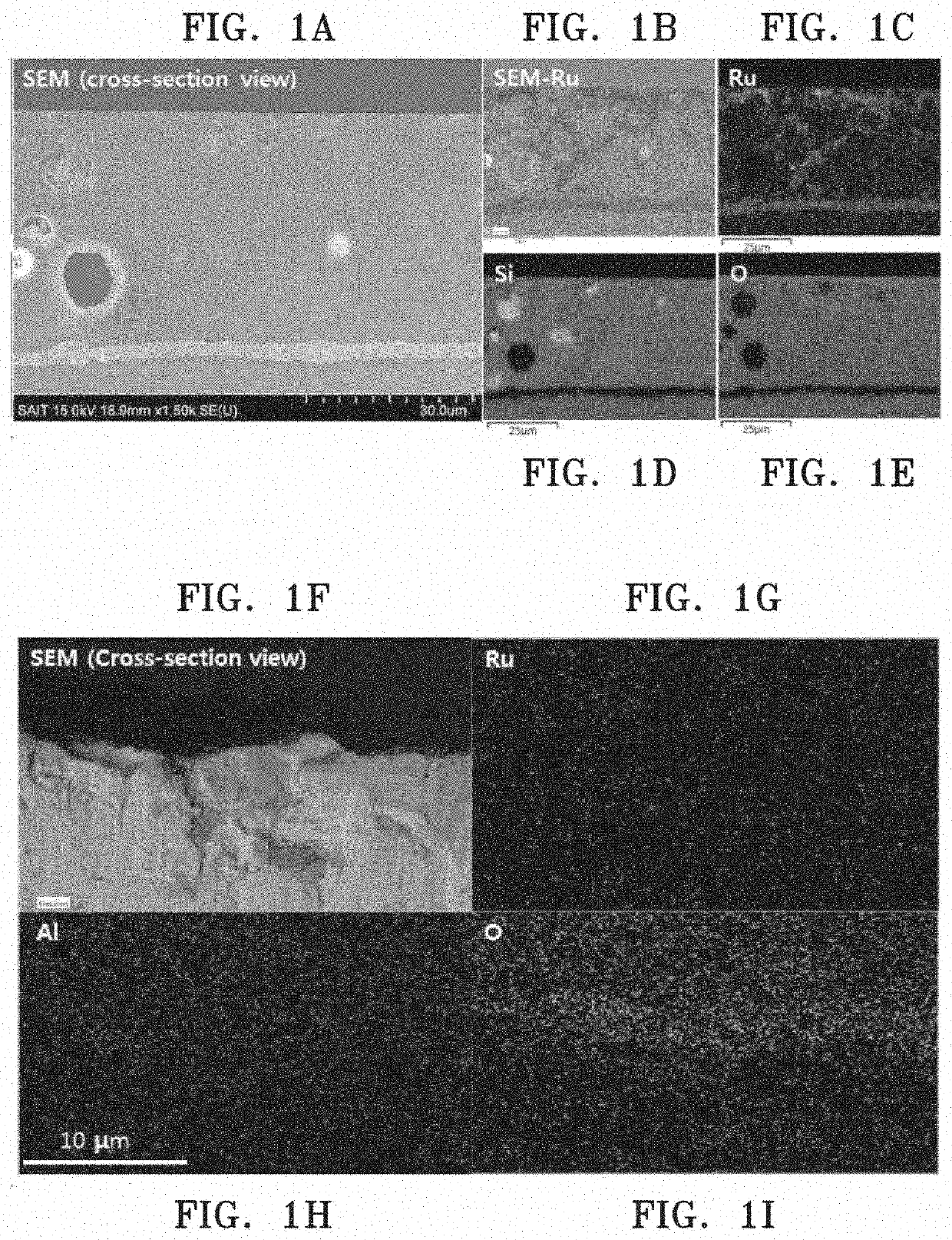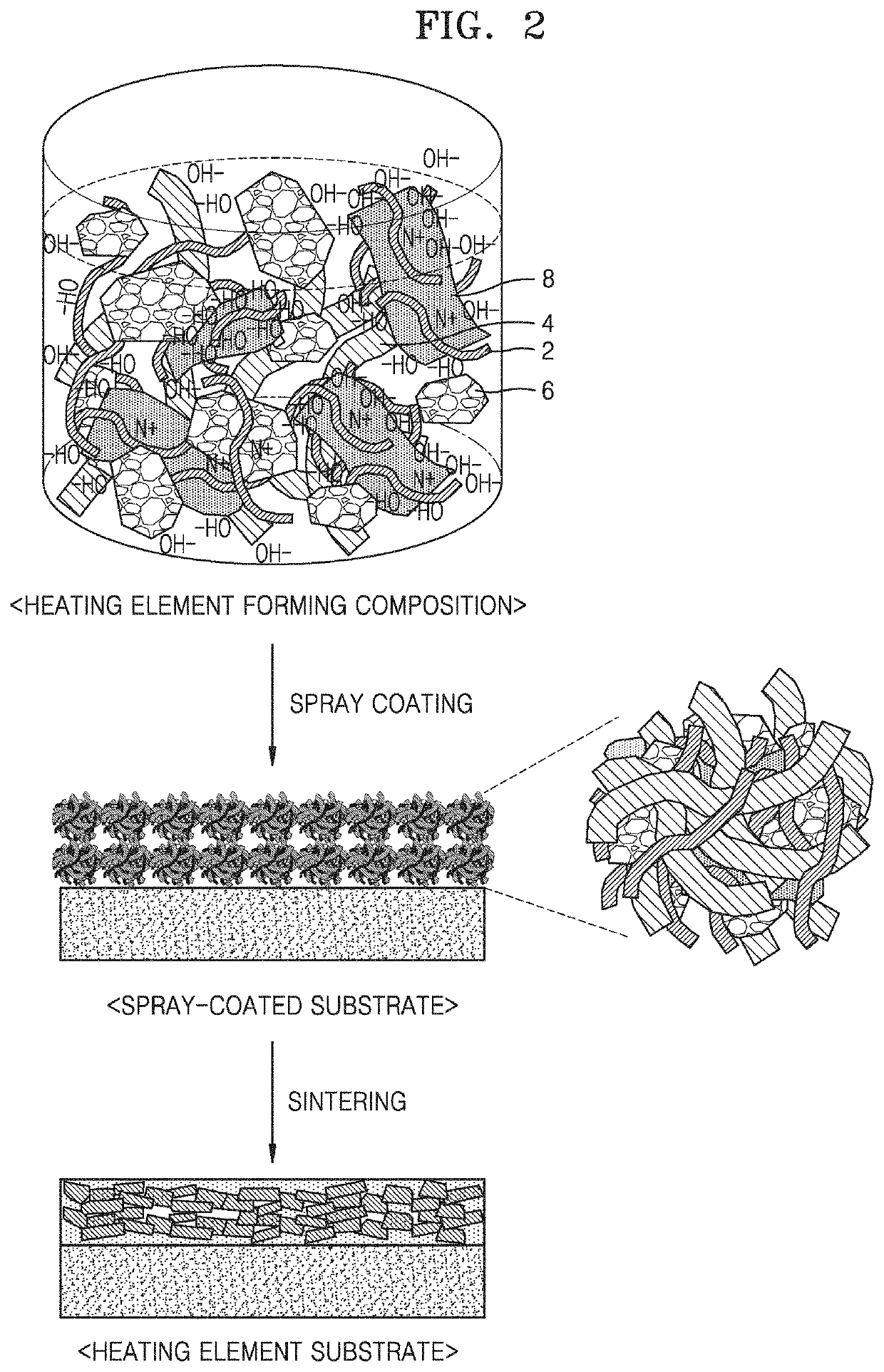Heating element, manufacturing method thereof, composition for forming heating element, and heating apparatus
a technology for heating elements and compositions, applied in the field of heating elements, manufacturing methods, compositions for forming heating elements, etc., can solve the problems of low heat generation efficiency and inability of generating elements to uniformly generate heat, and achieve excellent heat generation characteristics and high electrical conductivity.
- Summary
- Abstract
- Description
- Claims
- Application Information
AI Technical Summary
Benefits of technology
Problems solved by technology
Method used
Image
Examples
experimental example 1
-Functionalized Matrix Particles and Evaluation of Dispersion Stability
[0207]In order to prepare a matrix surface-functionalized with negative charges, 300 g of an enamel frit (D50− anions was prepared.
[0208]Meanwhile, in order to prepare a matrix surface-functionalized with positive charges, 100 g of an enamel frit (D503+ cations was prepared.
[0209]Zeta potential, electric mobility, and surface charge distribution of an untreated enamel frit, an enamel frits surface-treated with negative charges, an enamel frit surface-treated with positive charges, and RuO2 nano-sheets (to be mixed therewith later) were measured and shown in FIGS. 8A and 8B.
[0210]In addition, in order to evaluate dispersion stability of the enamel frits before and after surface treatment, 0.1 g of each of the neutral enamel frit which is surface-untreated, the enamel frits which are surface-treated with positive charges, and the enamel frits which are surface-treated with negative charges, was dispersed in water a...
experimental example 2
nce of Heating Element Using Surface-Functionalized Matrix Particles
[0218]1.8 g of the enamel frit surface-treated with negative charges and prepared according to Experimental Example 1 and 0.2 g of the RuO2 nano-sheets capped with the TBAOH described above were dispersed in 50 mL of water to prepare a coating solution. The coating solution was spray-coated on an enamel substrate at room temperature and dried at a temperature of about 110 to about 120° C. for 10 minutes. Then, the coated resultant was heat-treated at 750° C. for 16 minutes to manufacture a heating element.
[0219]Electrical conductivity with respect to mixing ratios of RuO2 nano-sheets was measured and the results are shown in FIG. 11. Electrical conductivity was measured as follows. A silver (Ag) paste was applied to opposite ends of the manufactured heating element and dried to form electrodes. Electrical conductivity of the heating element was measured by measuring resistance between the electrodes and measuring a ...
experimental example 4
f Binder
[0233]In order to identify the effects of using the enamel frit surface-treated with negative charges and prepared according to Experimental Example 1 and a binder, experiments were performed as follows.
[0234]0.5 g of hydroxypropyl methylcellulose (HPMC) was added to a coating solution prepared by dispersing 1.8 g of the enamel frit surface-treated with negative charges and prepared according to Experimental Example 1 and 0.2 g of RuO2 nano-sheets in 50 mL of water. The coating solution was spray-coated onto an enamel substrate at room temperature and the coated substrate was dried at a temperature of about 110° C. to about 120° C. for 10 minutes and heat-treated at 750° C. for 16 minutes to manufacture a heating element.
[0235]Table 7 below shows viscosity, dispersibility of coating solutions and thickness variations and electrical conductivity of the heating elements manufactured using the same in the presence and absence of HPMC.
[0236]
TABLE 7No HPMCwith HPMCViscosity (cps)...
PUM
| Property | Measurement | Unit |
|---|---|---|
| thickness | aaaaa | aaaaa |
| electrical conductivity | aaaaa | aaaaa |
| temperature | aaaaa | aaaaa |
Abstract
Description
Claims
Application Information
 Login to View More
Login to View More - R&D
- Intellectual Property
- Life Sciences
- Materials
- Tech Scout
- Unparalleled Data Quality
- Higher Quality Content
- 60% Fewer Hallucinations
Browse by: Latest US Patents, China's latest patents, Technical Efficacy Thesaurus, Application Domain, Technology Topic, Popular Technical Reports.
© 2025 PatSnap. All rights reserved.Legal|Privacy policy|Modern Slavery Act Transparency Statement|Sitemap|About US| Contact US: help@patsnap.com



